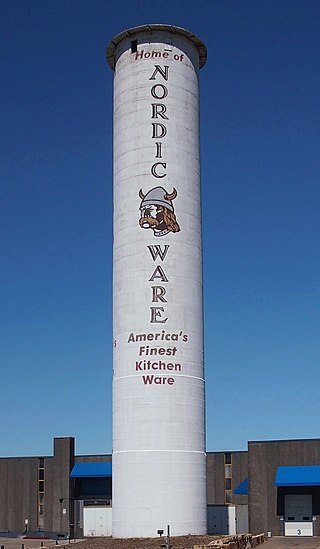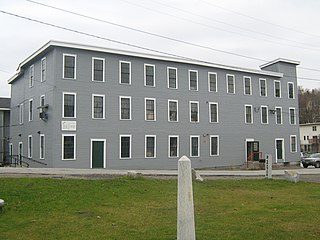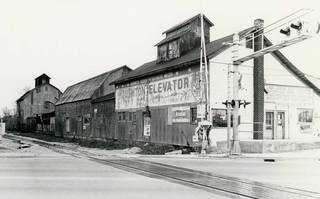
The Peavey–Haglin Experimental Concrete Grain Elevator is the world's first known cylindrical concrete grain elevator. It was built from 1899 to 1900 in St. Louis Park, Minnesota, United States, as an experiment to prove the design was viable. It was an improvement on wooden elevators that were continually at risk for catching fire or even exploding. Its cylindrical concrete design became the industry standard in the United States, revolutionizing grain storage practices. After its initial experiments, the Peavey–Haglin Elevator was never again used to store grain. Since the late 1960s it has been maintained on the grounds of the Nordic Ware company and is painted with their name and logo.
Adams is an unincorporated community in eastern Texas County, Oklahoma, United States. It is approximately 20 miles (32 km) east-northeast of the county seat, Guymon. The community is six miles north-northeast of Optima Lake. The post office opened June 14, 1930. The community was named for Jesse L. Adams, engineer for the Rock Island Railroad.
Hough is a small unincorporated rural community in Texas County, Oklahoma, United States, north-northwest of Guymon. The townsite was officially platted on July 20, 1928. The Beaver, Meade and Englewood Railroad built through the area in the 1929-1930 timeframe, and Hough was purposely sited along its route. That trackage was abandoned in 1972, but the Hough Woodframe Elevator, which was situated along the tracks, still exists and is on the National Register of Historic Places listings in Texas County, Oklahoma.
Baker is an unincorporated community in northeastern Texas County, Oklahoma, United States, ¼ mile north of U.S. Route 64. Tyrone lies six miles to the north-northwest on U.S. Route 54 and Turpin lies eight miles to the east at the intersection of Route 64 and U.S. Route 83 in adjacent Beaver County.
Eva is an unincorporated community in Texas County, Oklahoma, United States. It is located along State Highway 95, approximately two miles north of U.S. Route 412.
The Bernhard Warkentin Homestead, also known as Little River Stock Farm or Warkentin Farm, is a historic farm complex on East North Street in Halstead, Kansas. It was listed on the National Register of Historic Places in 1974. It was further declared to be a National Historic Landmark in 1990, nationally significant for its association with Bernhard Warkentin, a pivotal figure in the development and wide cultivation of durum wheat in the country.

The Chicago, Milwaukee and Pacific Railroad-Albert City Station, also known as the Albert City Depot, was built by the Chicago, Milwaukee, St. Paul and Pacific Railroad in 1899 to serve the farms around Albert City, Iowa. The railroad built the line from Des Moines to Spencer, Iowa, in 1899 to serve local agriculture. Albert City was platted the same year. The depot was built for passenger service as well as freight.
Mouser is an unincorporated community in Texas County, Oklahoma, United States. Mouser is 13.5 miles (21.7 km) north-northeast of Guymon and 11 miles (18 km) west of Hooker. The community of Straight is two miles to the west. The Beaver, Meade and Englewood Railroad (BM&E) reached the locale in the Summer of 1928, and two grain elevators in Mouser, the Mouser Grain Elevator and the Mouser Woodframe Grain Elevator/Collingwood Elevator, which were built along the BM&E's tracks, are now listed on the National Register of Historic Places listings in Texas County, Oklahoma.
Tracy, later named Muncy is an unincorporated community in Texas County, Oklahoma, United States. Tracy is 18.2 miles (29.3 km) west-northwest of Guymon. The Panhandle Townsite Company platted Tracy on May 1, 1931, intending for the community to become a commercial and agricultural center for the region on the BM&E line that extended from Forgan, Oklahoma to Keyes, Oklahoma. The Tracey Woodframe Grain Elevator in Muncy is listed on the National Register of Historic Places. Fred C. Tracy was the namesake of this town platted by the Panhandle Townsite Company, Fred Tracy was a secretary of the BM&E for several years. Tracy, unlike many other towns on the line failed to prosper. Arriving during the dust bowl had its obvious effects. In later years the diesel locomotive tacked yet another nail, being that Diesel engines did not have to stop every 10 miles as the steam engines did. Eva, Oklahoma to its west had greater success and an elevator there still remains today. The wood frame elevator did continue operation until around 1983. All that remains today is a scalehouse which may have been remnant of the depot and the fallen wood frame elevator. The remains of the stock pens which once shipped cattle remain to the northeast. The scars of the once upon a time rail still show their path, the rails themselves however sold to Mexico in the mid 1970’s. Milepost 77 of the line straightened out here at Tracy, to finish its jog due west to mile post 103.5, end of track, Keyes, Oklahoma.
The Tracy Woodframe Grain Elevator was a grain elevator in Muncy, Oklahoma. The elevator was built in 1931 along the Beaver, Mead & Englewood Railroad, the same year Tracy was founded. The elevator operated continuously from its opening until around 1983, outlasting the railroad only a mere 10 years after the last train left eastbound in 1972. On May 13, 1983, the elevator was added to the National Register of Historic Places. The elevator has fallen down. All that remains is a scalehouse that was possibly remnant of a depot for the railroad.
The Adams Woodframe Grain Elevator is a grain elevator in Adams, Oklahoma. The elevator was built in 1926, the same year the community of Adams was established by the Tex-Co Grain Company. The Chicago, Rock Island and Pacific Railroad opened a line past the grain elevator in 1929, which linked Amarillo, Texas to Liberal, Kansas. The elevator has mainly held wheat, the primary crop in the area, and operated continuously from its opening to at least 1983. The grain was shipped by railroad from Adams to markets in either Fort Worth, Texas or Galveston, Texas On May 13, 1983, the elevator was added to the National Register of Historic Places. It was burned down around August 22, 2018 because of safety issues.

The Hooker Woodframe Grain Elevator is a grain elevator in Hooker, Oklahoma. The elevator was built in 1926 by the Riffe & Gilmore Co. and operated by the Wheat Pool Elevator Company. Located along the Beaver, Meade and Englewood Railroad, which ran from the east at Beaver, Oklahoma to the west at Keyes, Oklahoma, the elevator served the local wheat industry. It was one of several built to compete with the Chicago, Rock Island and Pacific Railroad elevators in the region. The elevator was added to the National Register of Historic Places on May 13, 1983 and is one of two National Register of Historic Places listings in Texas County, Oklahoma located around Hooker.
The Baker Woodframe Grain Elevator is a historic grain elevator in Baker, Oklahoma. The wood frame elevator was built in 1926 along the Beaver, Meade and Englewood Railroad by the Riffe & Gilmore Company. The elevator operated continuously from its opening until the early 1980s. Modern grain trucks proved to be too large for it in the mid 80's. Additional construction of steel bins to the west were added making the elevator an overflow storage. Over the years it has ceased operations yielding to the steel bins around it. The Riffe Gilmore location does still operate to this day, being one of very few still operating under the name, nearing 100 years of continued operations.

The National Clothespin Factory is a historic industrial building at One Granite Street in Montpelier, Vermont. Built in 1918, it is a significant local example of an early 20th-century wood-frame factory, and was home to the nation's last manufacturer of wooden clothespins. Now adapted for other uses, the building was listed on the National Register of Historic Places in 2005.
The Grenola Mill and Elevator is a grain elevator complex on Railroad Avenue in Grenola, Kansas. It was built in about 1909 and was listed on the National Register of Historic Places in 2002.

The Knowles Grain Elevator, located on U.S. Route 64 in Knowles, Oklahoma, was built in 1913. It was listed on the National Register of Historic Places in 1983.
The Turpin Grain Elevator, located off U.S. Route 64 in Turpin, Oklahoma, was built in 1925. It was listed on the National Register of Historic Places in 1983.

The Houghton Elevator was a grain elevator located at 315 West Vienna Street in Clio, Michigan. It was listed on the National Register of Historic Places in 1982. The site is now home to Dotty's Feed and Pet Supply; the original elevator buildings are no longer extant.

The Historic Ely Elevator, also known as the Woitishek-King-Krob Elevator and Feed Mill, is an "iron-clad" wood-cribbed grain elevator, located in Ely, Iowa. The Historic Ely Elevator was built in 1900 along the Burlington, Cedar Rapids and Northern Railway. It is a contributing property of the Dows Street Historic District, which is listed on the National Register of Historic Places.
The Beaver, Meade and Englewood Railroad (BM&E) extended from Beaver, Oklahoma to Keyes, Oklahoma in the Oklahoma Panhandle, about 105 miles. It was chartered in 1912, and abandoned in 1972.








